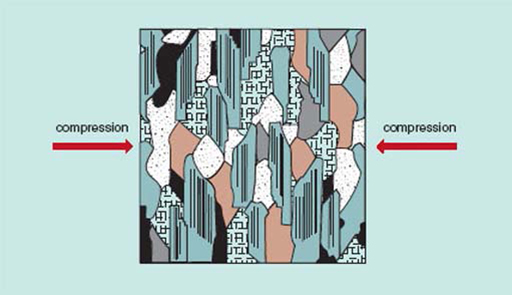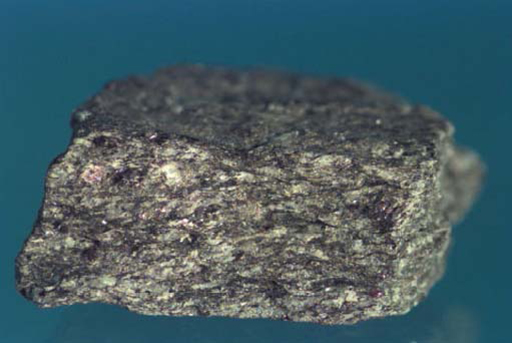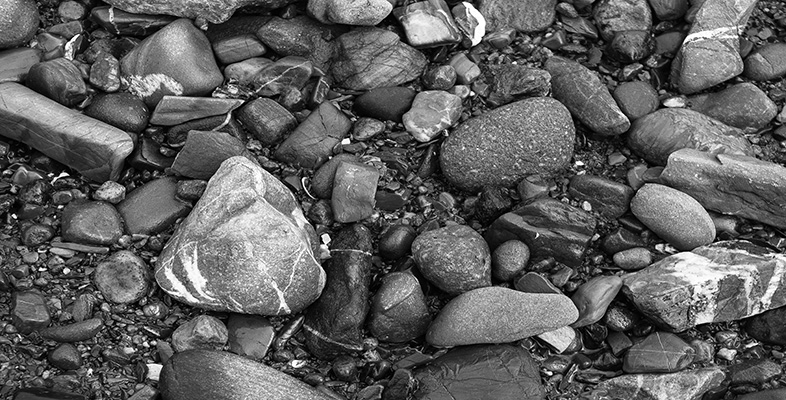1.5.2 Metamorphic recrystallisation
To consider metamorphic recrystallisation at its simplest, let's begin by imagining a sedimentary rock composed entirely of quartz grains – a quartz sandstone. Sandstone is a sedimentary rock and so has a fragmental texture (see Figure 7b). When it is subjected to high temperature and high pressure no new minerals can form because there are no other minerals present with which the quartz grains could react. All that can happen is that the quartz grains recrystallise and the rock known as quartzite is formed. The original fragmental texture is obliterated and replaced by a crystalline texture. Likewise, when a pure limestone, comprising calcite (i.e. CaCO3) is metamorphosed, the calcite recrystallises, and marble is produced. In these cases the rock adjusts to a high pressure or temperature by slowly recrystallising in a denser, more compact, form.
In most cases, however, we start with a rock containing several different minerals, giving a richer chemical mix for metamorphic reactions to work with. At sufficiently high temperature or pressure, the original minerals react with each other, and new mineral crystals grow. In order to do this the constituent atoms must diffuse at different rates through the rock, but diffusion is extremely slow so atoms can move only very small distances in a given amount of time. The chemical rearrangement of the rock therefore entails the growth of small crystals unless the temperature is particularly high, in which case larger crystals can grow. Whenever metamorphism occurs in the compressional environment of continental collision zones (regional metamorphism), the rock is also subject to directed pressure and this also has an effect on the way the minerals crystallise. In the case of the metamorphism of mudrocks, mica crystals are formed during metamorphism. Mica crystals are characteristically platy in shape, which reflects the fact that the atoms in mica are arranged in layers or sheets. When platy minerals grow during metamorphism the energetically most favourable pattern of growth is one in which their flat surfaces lie more or less parallel, and at right angles to the main direction of imposed pressure (Figure 14). Likewise, any elongate crystals grow aligned parallel with each other.

Activity 6
In what way is the metamorphic texture shown in Figure 14 the same as the texture found in igneous rocks (Figure 3) and in what way does it differ?
Answer
The metamorphic rock has a crystalline texture, like igneous rocks. However, it also has mineral layering, or alignment, whereas the crystals in igneous rocks have grown in random directions.
The alignment of platy minerals means that the rock has a series of closely spaced planes of weakness running through it, so it tends to split apart into fairly flat pieces. The rock is said to have a foliation, because its mineral grains are aligned like a stack of leaves (foliage) lying one on top of the other. A classic example is slate, a metamorphic rock with an extremely fine grain size that can be split into thin sheets used for roofing. Slate, and the coarser-grained metamorphic rock schist (pronounced ‘shh-ist’, to rhyme with ‘mist’) (Figure 15) have marked foliation because they contain a lot of mica. But not all metamorphic rocks are as rich in mica. In such cases metamorphism can still produce a banding effect, but here the minerals grow segregated into alternating bands a few millimetres to centimetres thick. Bands of light-coloured minerals alternate with bands of dark-coloured minerals, and the rock is known as gneiss (pronounced ‘nice’). In general, the coarser the grain size of a metamorphic rock, the higher the temperature and/or pressure.

Activity 7
Is the control on grain size in metamorphic rocks the same as in igneous rocks?
Answer
No. In igneous rocks grain size is controlled by cooling rate (and crystals grow from a liquid); the slower the cooling, the coarser the grain size. In metamorphic rocks grain size is controlled by pressure and temperature (and crystals grow by transformation of existing minerals in the solid state); the higher the temperature and pressure, the coarser the grain size.
The end product of metamorphism depends on two main variables – the chemical composition of the starting rock, and the pressure and temperature conditions under which metamorphism occurred. A useful analogy is with cooking – the product of baking in an oven depends on the ingredients that went in (chemical composition) and the temperature that the ingredients were subjected to in the oven. Just as the shape, colour and taste of food from the oven gives us clues about the ingredients and the baking conditions, so the texture and mineralogy of a metamorphic rock allow us to say something about the original rock type and the temperature and pressure conditions in the crust where metamorphism occurred.
Question 3
Compare and contrast contact metamorphism and regional metamorphism in terms of (a) the presence of foliation and (b) the distribution of the affected rocks.
Answer
(a) Rocks formed by regional metamorphism possess a foliation due to the alignment of platy minerals that grew during compression. Rocks formed by contact metamorphism do not show foliation.
(b) Contact metamorphic rocks are confined to a narrow band in the rocks surrounding an igneous intrusion. Regional metamorphism occurs in vast tracts of land as a result of mountain building.
